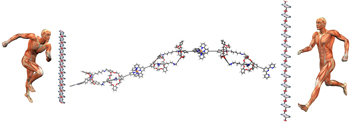

| Visitors Now: | |
| Total Visits: | |
| Total Stories: |

| Story Views | |
| Now: | |
| Last Hour: | |
| Last 24 Hours: | |
| Total: | |
Nano-Machines Mimic Human Muscle
For the first time, an assembly of thousands of nano-machines capable of producing a coordinated contraction movement extending up to around ten micrometers, like the movements of muscular fibers, has been synthesized by a CNRS team from the Institut Charles Sadron.

© Wiley-VCH Verlag GmbH & Co.KGaA. Reproduced with permission. This image is available from the CNRS photo library, [email protected]
Nature manufactures numerous machines known as “molecular”. Highly complex assemblies of proteins, they are involved in essential functions of living beings such as the transport of ions, the synthesis of ATP (the “energy molecule”), and cell division. Our muscles are thus controlled by the coordinated movement of these thousands of protein nano-machines, which only function individually over distances of the order of a nanometer.
Not anymore: for the first time, Giuseppone’s team has succeeded in synthesizing long polymer chains incorporating, via supramolecular bonds (1), thousands of nano-machines each capable of producing linear telescopic motion of around one nanometer. Under the influence of pH, their simultaneous movements allow the whole polymer chain to contract or extend over about 10 micrometers, thereby amplifying the movement by a factor of 10,000, along the same principles as those used by muscular tissues.
These results, obtained using a biomimetic approach, could lead to numerous applications for the design of artificial muscles, micro-robots or the development of new materials incorporating nano-machines endowed with novel multi-scale mechanical properties.
(1) A supramolecular bond is an interaction between different molecules that is not based on a traditional “covalent” chemical bond but instead on what are known as “weak interactions”, thereby constituting complex molecular structures.
Citation: Muscle-like Supramolecular Polymers – Integrated Motion from Thousands of Molecular Machines, G. Du, E. Moulin, N. Jouault, E. Buhler, N. Giuseppone, Angew. Chem. Int. Ed. On line on the 18/10/2012 (DOI: 10.1002/ange.201206571).
Contacts and sources:
CNRS (Délégation Paris Michel-Ange)


